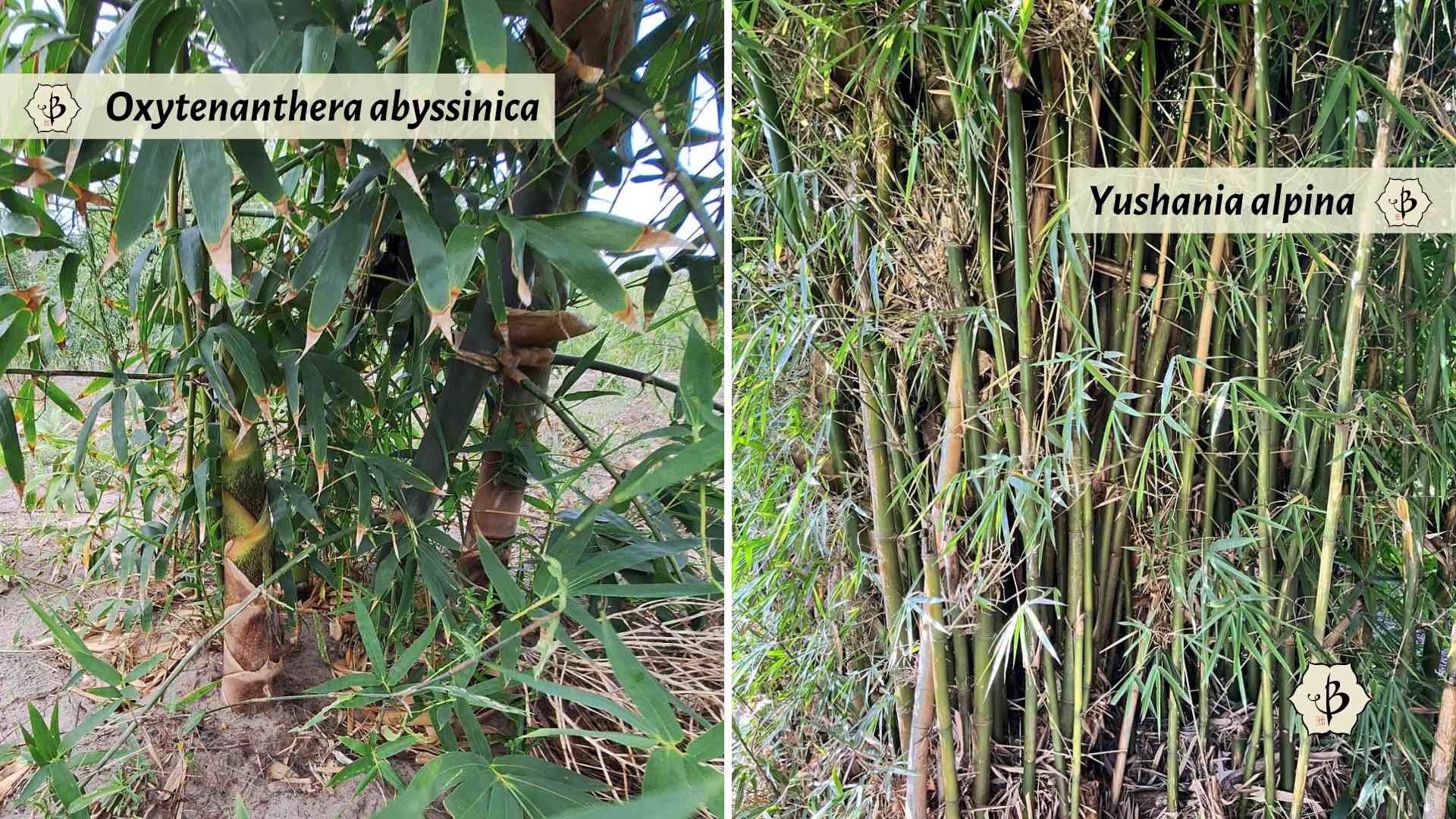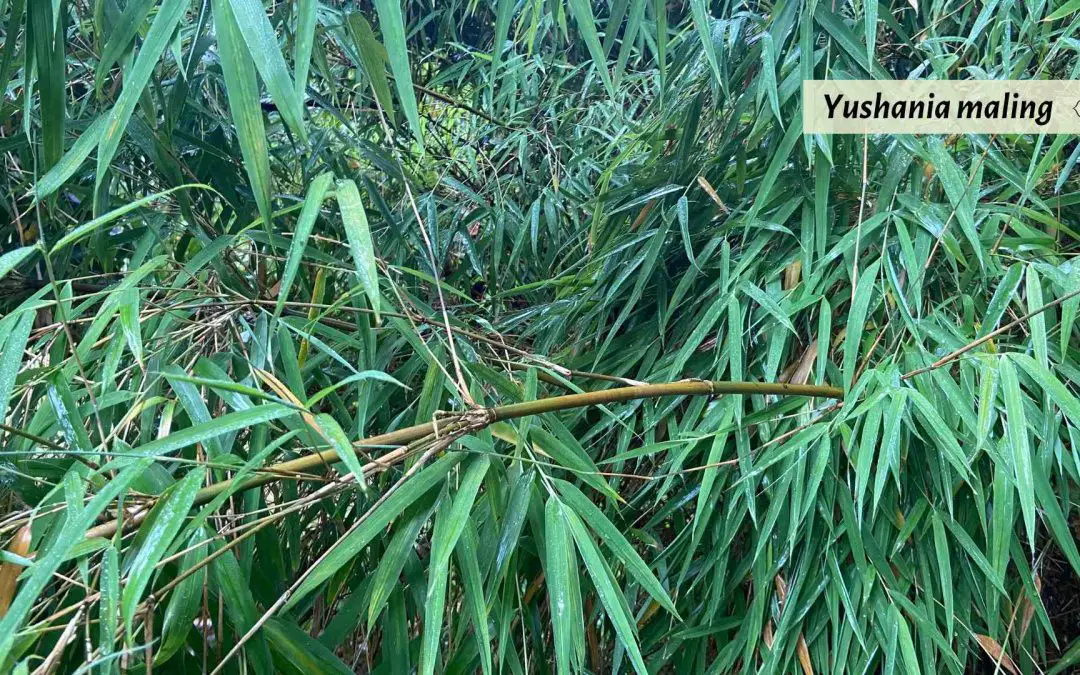Yushania is a genus of temperate bamboo with dozens of medium-sized, thornless species found in the highlands of Central Asia and Africa. The most widely accepted systems of taxonomy place about 70 species in this genus, but not all authors agree. Many of these bamboo species were formerly listed as Arundinaria, while many previously included have since been reclassified as Fargesia and other genera. Due to their ambiguous rhizome structure, they are variously described as clumping, spreading, or open-clumping. In any case, we are still some distance from a firm consensus. As it stands, the genus Yushania comprises a diverse variety of species with a wide geographical distribution.
This article is part of an extended series about bamboo species and taxonomy. Explore some of these links to discover more.
- Bamboo Species Directory
- Introducing bamboo: Genus by genus
- Bambusa oldhamii: Chinese timber bamboo
- Phyllostachys viridis ‘Robert Young’
- Pseudosasa amabilis: Tonkin bamboo
- Schizostachyum brachycladum: Sacred Bali bamboo
- Thyrsocalamus liang: Thai bamboo
Characteristics of genus Yushania
Running or Clumping?
Because of its uncertain taxonomy and broad diversity, it’s hard to make clear generalizations about this genus. It seems that these are clumping bamboo, but in the Arundinarieae tribe, they are more closely related to the runners. Most authors describe them as pachymorphic, consistent with clumping bamboo, but with longer rhizomes more prone to spreading. Such varieties are also called open-clumpers. Many members of Yushania were previously categorized as Arundinaria, which are generally agreed to be runners. (NOTE: Don’t be confused between the Arundinaria genus and the Arundinarieae tribe.)
As with other exotic montane bamboo varieties — like Thamnocalamus, Borinda, Drepnostachyum, and Fargesia — Yushania holds an unusual place in the bamboo catalog. These other genera are sometimes considered tropical, based on their clumping rhizomes, but they generally come from the mountains and are exceptionally cold hardy. Yushania is also similar to Himalayacalamus, a genus of slowly running, montane bamboo.
Size and Shape
As a general rule, these are medium-sized bamboo, mostly ranging about 20 to 30 feet tall, with culms rarely more than an inch in diameter. Not thick and sturdy enough to stand erect, they tend to lean over, producing an attractive, weeping appearance. Leaves are fairly thin and wispy, growing densely and cascading gracefully. The branching pattern also resembles Himalayacalamus, with several small branches emerging at each node joint.
Closely related, there are just a few species from the genus Bashania, native to Southern China and Vietnam. These are also slow-spreading runners that usually have slender culms and dense foliage.

Distribution of genus Yushania
One feature that could raise doubt about the classification of Yushania is its wide geographic distribution. Current systems group about 70 species that are native to places as far-flung as the Himalayan foothills, Southeast Asia, China, the Philippines, and sub-Saharan Africa.
These bamboo varieties grow in temperate and subtropical climates. What these regions share in common is their high altitude, which can reach up to 10,000 feet (3,000 meters). The name Yushania comes from Yu Shan, the tallest mountain in Taiwan.

Varieties of Yushania
Depending on the source, you may find somewhere between 65 and 85 species of Yushania, occurring predominantly in the wilderness of southern China. There are a small handful of these which are of particular interest.
Yushania alpina: Sometimes listed as Oldeania alpina, this species is notable for being one of a few bamboo varieties native to Africa. Commonly referred to as African Highland Bamboo, it grows in many of the same regions as African Lowland Bamboo (Oxytenanthera abyssinca), but at higher altitudes and not as widespread. While Lowland Bamboo occurs in most of sub-Saharan Africa, Yushania alpina is more local to East Africa, namely Ethiopia, Kenya, Uganda, Tanzania, Zambia and Malawi.
One of the larger members of the species, this variety has been known to grow up to 50 or 60 feet tall. With its short rhizomes, it is usually described as a clumper. But when it comes to running and clumping, the classification of Yushania is not perfectly clear.
Yushania anceps: This is probably the most popular ornamental species in the genus, better known as “Pitt White.” From its bushy, drooping appearance, the close affinity to the genus Fargesia is evident. But the rhizomes spread more aggressively. Rhizomes of this plant also run deeper, making it a good candidate for erosion control. Like most montane bamboo varieties, these prefer cooler climates with mild summers. They are cold hardy to about 0º F.
Yushania elegans: Native to northeast India, Myanmar, and southern China, this species prefers subtropical conditions in the foothills of the Himalayas. The plant is moderately tall, up to 20 or 30 feet, with slender, graceful culms and abundant foliage.
Yushania maling: A rare variety, also native to northeastern India and Nepal, Y. maling has been introduced to the United Kingdom as an ornamental, where it does well in the cool climate. The rhizomes of this plant have long necks, making it behave more like a runner, although botanically more of a clumper. Culms are no more than one inch in diameter, and anywhere from 10 to 20 feet tall.
Further reading
To learn more about using and maintaining bamboo, take a look at some of the other articles.
FEATURE IMAGE: Yushania maling at Kew Garden in London. (Photo by Fred Hornaday)

























